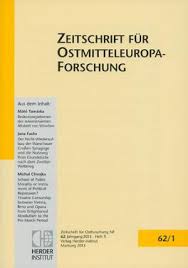Pilenai – das litauische Masada. Auf den Spuren einer Legende
Pilėnai—the Lithuanian Masada: Unravelling a Legend
Author(s): Darius BaronasSubject(s): Christian Theology and Religion, Local History / Microhistory, Middle Ages, 19th Century
Published by: Verlag Herder-Institut
Keywords: Teutonic Order; Lithuania; historiography; Romanticism; heroism; Pilėnai;
Summary/Abstract: The subject matter of this article is the tradition of the heroic defence of the castle of Pilėnai that culminated around the events of February 1336, when the Lithuanians had been engaged by the Teutonic Knights and their allies in the crusade. According to common opinion, the defence of the Pilėnai castle and the behaviour of its leader, Duke Margiris, constitute a paradigmatic example of Lithuanian bravery in defence of their freedom to the bitter end—suicide. The application of a layer-by-layer method of textual criticism allows us to uncover the point of departure and the subsequent points of destination of the story of Pilėnai. The “close reading” of the only reliable and detailed contemporary source, the chronicle of Wigand of Marburg (1394), has revealed a picture that stands in stark contrast to all later (secondary) sources. While we cannot take at face value each and every narrative detail of the story, the bloody chaos that erupted in the castle and the lack of active defence on the part of the Lithuanians are, in our view, substantially true. The first motifs of the heroic defence emerged only with the Polish chronicler Jan Długosz (1415- 1480). His lead was followed up by all subsequent historians and writers who produced a magnificent picture based on the imitation of historians of Antiquity and their own reservoir of rhetoric knowledge. The Polish-Lithuanian historian Maciej Stryjkowski and the Prussian historian Caspar Schütz contributed most considerably to the development of the legend of Pilėnai in the 16th century. After a lull in the Baroque period, a revival of the legend occurred in the time of Romanticism. The image of the heroic defence of Pilėnai was once again reproduced on the pages of the works of German/Prussian writers and historyians such as August L. von Schlözer, Ludwig von Baczko, August von Kotzebue and especially Johannes Voigt. It was from them that Polish and Lithuanian romantic writers and historians, such as Simonas Daukantas, Teodor Narbutt, Władysław Syrokomla and Józef I. Kraszewski, drew the inspiration for their own literary images about the siege and defence of Pilėnai castle. Since then the defence of freedom and the idealization of the suicide has become part and parcel of the Pilėnai story. This story was viewed as essentially Lithuanian, permeated as it was with blood- and native language-related imagery. That is why it was avidly exploited by those Lithuanian intellectuals who at the end of the 19th century saw it as their mission to fill with content the not-too-well developed Lithuanian historical and national consciousness. This article has sought to uncover the main stages in the development of the legend of Pilėnai and to display the ups and downs conditioned by the changing intellectual climate. The analysis of the Pilėnai story offers a superb vantage point into the current psyche of those numerous Lithuanians whose national self-consciousness is (still) heavily beholden to nineteenth-century Romanticism and twentieth century nationalism.
Journal: Zeitschrift für Ostmitteleuropa-Forschung
- Issue Year: 65/2016
- Issue No: 3
- Page Range: 345-372
- Page Count: 28
- Language: German

